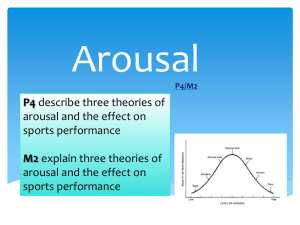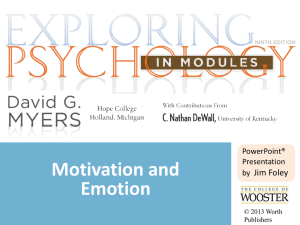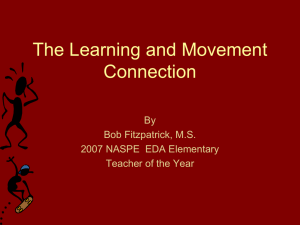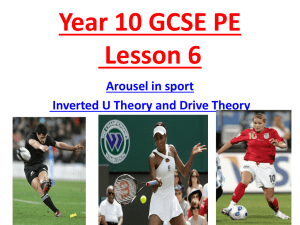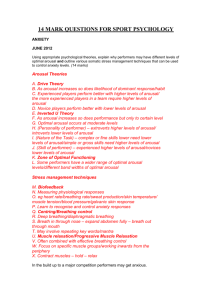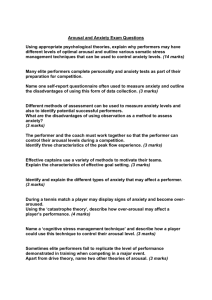AROUSAL THEORIES
advertisement
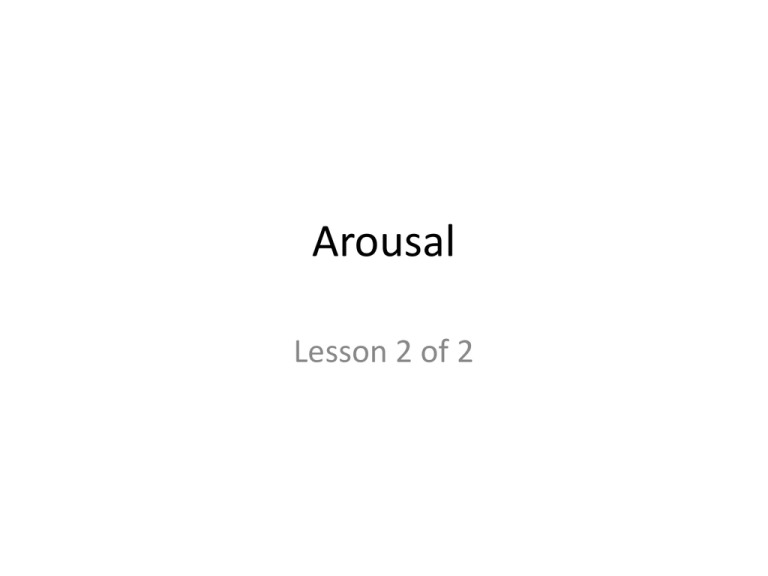
Arousal Lesson 2 of 2 Home learning • Questions on page 139 Connector Name and describe what is shown Connector Group presentation review Explain and give examples about the following theories: Drive reduction Inverted U Catastrophe AROUSAL THEORIES (1) DRIVE THEORY A theory of arousal that proposes a linear relationship between arousal and performance; as arousal increases so does the quality of performance. Devised by Hull in (1943) and Spence & Spence (1966) Is concerned with a proportional linear relationship between arousal and performance. DRIVE THEORY Performance = Habit strength X Drive P=HD The more an elite sports person is aroused the better their performance due to the dominant response being chosen is habitual. The more a beginner sports person is aroused the dominant response may be incorrect and high levels of arousal can cause a deterioration in performance. PROBLEMS WITH DRIVE THEORY • The habitual behaviour/ dominant response is not always the correct one (think of beginners) • By increasing drive (arousal) performers often resort to previously learned skills because they are dominant but may be incorrect. • Even highly skilled players ‘choke’ in highly charged situations. AROUSAL THEORIES (2) INVERTED U THEORY A theory of arousal that considers that optimal performance occurs when the performer reaches an optimal level of arousal. Devised by Yerkes and Dodson (1908) Is concerned with the optimal level of arousal being found through observations of performance. Most athletes and coaches can relate to this theory PROBLEMS WITH INVERTED U THEORY • Critics question if optimal arousal always occurs at the midpoint of the curve. • One curve does not explain the different optimal levels of arousal needed for simple and complex tasks. AROUSAL THEORIES (3) CATASTROPHE THEORY A theory that predicts a rapid decline in performance resulting from the combination of high cognitive anxiety and increasing somatic anxiety. Devised by Hardy and Frazey (1987) Is a development of the Inverted U theory but involves a faster and more dramatic reduction in performance. It is more a model than theory because it tries to predict human behaviour rather than explain it. CATASTROPHE THEORY Point A Cognitive anxiety is high. Somatic anxiety is low. Performance is enhanced. Point B Cognitive anxiety is high. Somatic anxiety is high. Performance can deteriorate. Point D Performance does not return to original level immediately even though performer is trying to decrease arousal. Point C Performance still deteriorating. CATASTROPHE THEORY Physiological arousal is related to performance in an inverted ‘U’ fashion when the athlete is not worried or has low cognitive anxiety state anxiety. If cognitive anxiety is high, the increases in arousal pass a point of optimal arousal and a rapid decline in performance occurs (the catastrophe). It would be very difficult to recover from this point. AROUSAL AND ITS IMPACT ON PERFORMANCE Once we attain our optimum level our reactions are at their fastest, we are able to screen out irrelevant information and do NOT suffer from Attentional Narrowing. Attentional Narrowing: Focusing on too narrow a range of information or on the performance of a skill; this causes the performer to ignore important cues or information. This occurs when a performer is so tightly focused on performing the skill, or on a small part of the display (e.g. the defender in front of them), that they do not attend to other important aspects or they miss important cues (e.g. team mates they could pass to). Outcomes • Some will be able to critique the ZOF and explain what is required to enter a peak flow state • Most will be able to compare the ZOF with the inverted U theory • All will learn how to describe adaptations to the inverted U theory and give examples Provide a sporting example for A and B ZOF – Consider the type of skill Discussion • Differences and similarities between ZOF and inverted U theory Prove it review Do you understand the following? • drive, inverted U and catastrophe theories • practical applications and impact on performance • Zone of Optimal Functioning and peak flow experience

